Dry rot (Serpula Lacrymans) is the most famous of the rots and is the most serious. If left to grow dry rot will cause thousands of pounds worth of damage, dry rot can cause timber decay at lower moisture content than wet rot that is why the cause of the problem needs to be identified and rapid drying of the area is needed.
Have a read on our blog and read about Meg the dry rot search dog we work with, Meg is brilliant it covering large areas for non destructive surveys, she is the first dry rot search dog to have a video of her on youtube where she finds dry rot in a property in Wiltshire. We are available to carry out dry rot surveys with Meg and her handler, please contact us for prices.
How do Complete Preservation know that our dry rot treatment works and can offer a long term guarantee? We grow dry rot in our laboratory, we use this to test our dry rot treatments and also for training our dry rot search dog.
Dry rot repair works are mostly over specified, there is this mis conception that everything needs to be cut back 1 meter. This maybe acceptable on a 3"x2" piece of softwood, but not an historic listed building. We have worked on some very large listed building with huge oak timbers built into soaking wet walls that would take years to dry down, these needed protection by the use of penetrating gels to ensure that whilst drying down no dry rot will come back and attack the timbers. It also important that if timbers are to be left, that bearing ends of timbers are drill resistance tested to check the structural integrity of the timber.
We offer the complete service from initial survey, rapid drying of the area in question using Drieaz dehumidifiers along with air movers, sympathetic repairs along with chemical treatments where necessary.
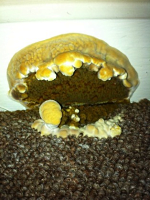
This image shows dry rot in the basement of a property in Wiltshire, Complete Preservation also carried out the treatment of the dry rot outbreak.
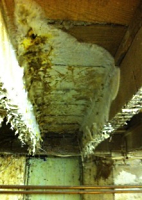
This image shows dry rot in a newly renovated property in Somerset, Complete Preservation also carried out the treatment of the dry rot outbreak.
Dry rot (Serpula Lacrymans) is the most famous of the rots and is the most serious. If left to grow dry rot will cause thousands of pounds worth of damage, dry rot can cause timber decay at lower moisture content than wet rot that is why the cause of the problem needs to be identified and rapid drying of the area is needed.
Unfortunately dry rot is rather 'secretive' in its activity, preferring stagnant, humid conditions. Hence, when it is discovered the damage it has caused is frequently very extensive.
Dry rot treatment and surveys need to be carried out by an experienced professional surveyor with an understanding of buildings and the ability to kill off the dry rot outbreak first time.
Read our blog and how we saved a client thousand of pounds as no dry rot treatment was necessary http://blog.completepreservation.co.uk/2014/07/24/why-do-you-need-a-qualified-rot-specialist-for-a-dry-rot-survey/
Read our blog where we have lots of pictures of dry rot, this may help you identify your dry rot outbreak http://blog.completepreservation.co.uk/2014/04/26/dry-rot-pictures/
Contact Complete Preservation for a dry rot survey-report, investigation and treatment. We cover Trowbridge, Bath , Frome, Devizes, Chippenham, Bradford On Avon, Calne, Marlborough, Swindon, Bristol, Wiltshire and Somerset (the South West)

This image shows decay by the wet rot cellar fungus, Coniophora Puteana in a Wiltshire property. Decay by wet rot fungi such as the cellar fungus, Coniophora Puteana, tends to remain more localized.
Wet rot (Coniophora Puteana) the Cellar Fungus is the most common cause of wet rot of timber in buildings this is not as expensive to repair as dry rot and is normally found in skirting boards and sub floor plates and joists.
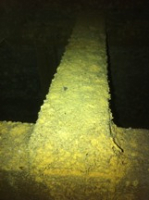
This image shows the signs of long-term active woodworm infestation by the Common furniture beetle, this property was in Trowbridge Wiltshire.
As the name suggests, is the most common insect that attacks softwood and European hardwood. Larvae hatch out from the eggs and burrow into the timber feeding on the sapwood, progressively weakening it, for up to four years; when fully grown the larvae are approximately 3mm long. Adult beetles emerge from the timber at the completion of the pupa stage through 1-2mm diameter flight holes. Treatment of the common furniture beetle is by means of a water-based micro emulsion insecticide containing permethrin which is applied under a course spray treatment to all accessible timber surfaces. The common furniture beetle (Anobium Punctatum) is normally found in loft areas , under stairs, suspended ground floors and other areas affected by damp.
We carry out lots of common furniture beetle and woodworm treatments, contact Complete Preservation for a specialist woodworm survey in Bath, Trowbridge, Frome, Chippenham, Marlborough, Devizes, Wiltshire and Somerset. We cover the South West for timbers with woodworm and common furniture beetle infestation.
The common furniture beetle (Anobium Punctatum) is normally found in loft areas around the hatch, under stairs, sub floors and other areas affected by dampness.
Click on our Youtube video to see an active woodworm infestation of a sub floor https://www.youtube.com/watch?v=Ja1GUwQsg88
Read our blog post on woodworm treatment and what equipment is needed http://blog.completepreservation.co.uk/2013/05/29/woodworm-and-deathwatch-beetle-treatment
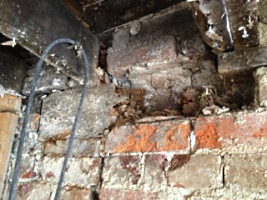
This image shows the signs of long term active Deathwatch beetle infestation. Joist ends were destroyed and the also the wall plate in this Somerset property.
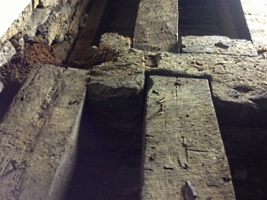
This image of a large bearing end timber in a Wiltshire property was destroyed by a Deathwatch beetle infestation, and needed a timber resin repair.
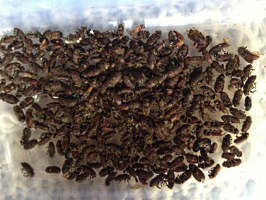
This image shows the Deathwatch Beetle (Xestobium Rufovillosum) from a property in Wiltshire.
Deathwatch beetle is normally found attacking hardwood timbers especially when timbers are partially decayed by fungal decay. We normally find this infestation on the bearing end timbers built into walls and lintels. Sometimes the damage is so extreme the bearing end timbers will require a timber resin repair or a whole new timber.
The adult Death Watch Beetle is 6-9mm long and chocolate brown, the life cycle can be around 10 years depending on conditions.
The most important part of treatment for deathwatch beetle is the bearing end of timbers, because this area is more likely to suffer from dampness. Always make sure the surveyor measures the moisture content of the timber as close to the bearing end as possible and inspect the area externally for defective pointing or leaks. If high readings are noted we would recommend further investigation is necessary.
Treatment of deathwatch beetle is by means of an organic solvent, water-based micro emulsion, pastes, gels and especially the drying down of timbers. We carry out lots of Deathwatch beetle treatments, contact Complete Preservation for a specialist deathwatch beetle survey in Bath, Trowbridge, Frome, Chippenham, Devizes, Marlborough, Malmesbury, Glastonbury, Shepton Mallet, Calne, Swindon, Bristol, Wiltshire and Somerset. Our surveying and treatment areas cover the South West for timbers with deathwatch beetle infestation and woodworm.
Contact Complete Preservation for a fixed price dry rot, woodworm and deathwatch beetle specialist survey and treatment in Bath, Trowbridge, Frome, Chippenham, Devizes, Marlborough, Malmesbury, Glastonbury, Shepton Mallet, Calne, Swindon, Bristol, Wiltshire and Somerset. We cover the South West for woodworm infestation, dry rot and fungal decay treatments.
What is condensation and why is it a problem now? One of the biggest points of confusion for homeowners...
What is condensation and why is it a problem now? One of the biggest points of confusion for homeowners...
What is condensation and why is it a problem now? One of the biggest points of confusion for homeowners...
What is condensation and why is it a problem now? One of the biggest points of confusion for homeowners...
What is condensation and why is it a problem now? One of the biggest points of confusion for homeowners...






Copyright 2017 Complete Preservation All Rights Reserved. | Web design by Dsgn One
